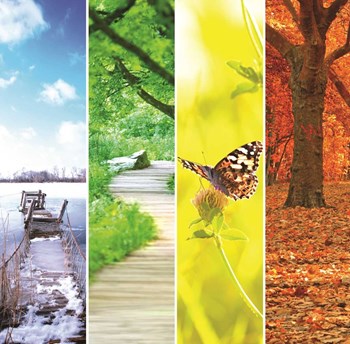
People aren’t the only life on your association's property; there are plants, trees, and other living landscaping elements, as well. More than just decoration, these features provide the community a vitality and serene pleasure only nature can provide. And whether you're a sprawling suburban HOA or in the city proper with just a courtyard or tree well, the lawn, trees and flowers in your landscape need regular maintenance throughout the year in order to stay healthy and vibrant, with special treatment each season to suit the stages of their life cycles.
Springtime is Prep-Time
“You'll be able to enjoy your garden through the summer if you prep it in the spring,” says Julie Watson, lead gardener with R&S Landscaping in Midland, New Jersey. After clearing the lawn of any branches, leaves or trash, now is the time to dethatch the lawn, clearing out old, dead grass and organic buildup.
Removing debris that has accumulated over the winter is essential, says David Protell, president of Manhattan-based Chelsea Garden Center, “because it can harbor insects, insect egg casings and fungus spores. So the cleaner the landscape is, the less likely it's going to have problems.” Also, dethatching the lawn allows water and nutrients from fertilizer to penetrate the surface.
Spring is the time to address the damage done by the snow and winds of winter. “It's basically an assessment to see what needs to be pulled and replaced,” says Protell. For one thing, “in winter, the arborvitae's will have been bent over or broken.”
Get Snippy
Evergreens and weak-wooded trees are particularly susceptible to snow damage. Unable to draw moisture from the frozen ground, their leaves or needles turn brown. If the winter burn damage is minimal, the brown tips of evergreens can be snipped off. If the browning is more extensive, the shrubs might need to be replaced entirely.
If you have roses, mid-March to April is the time to start cutting them back, almost in half, so they will bloom with all new growth.
When assessing the need to replace mulch in the spring, “you go out and see how much mulch you have already on your property,” says Christopher Conway, a certified arborist with Barlett Tree Experts in Westbury. “If you've already put a lot of mulch there over the previous years, you simply turn it and save yourself the cost of re-mulching.”
Nip’em in the Bud
Early spring is the time to stop weeds from sprouting before the temperature reaches and stays at 55 degrees for several consecutive days, at which time crabgrass germination occurs. The professionals recommend that a pre-emergent herbicide weed killer be applied before they emerge from the soil.
After thoroughly weeding the lawn and plant beds, apply a pre-emergent fertilizer to boost the nitrogen for the roots of the grass and nourish pre-emergent seeds. “In spring, your daffodils and tulips are blooming,” says Watson. “One way to ensure they bloom for next year is to put down a bulb fertilizer and spray them with deer spray or 'bunny-scram' anti-rabbit repellent.”
One common mistake is fertilizing too early. “Don’t rush it,” warns Watson. “If it is too cold nothing will adhere and it is just a waste of money. Wait until the last frost-free day, around Mother’s Day, to plant your flowers.”
Some plants might look like they’ve been beaten to death by winter but actually might just need some time to rejuvenate. Scrape the side of the plant with your fingernail to see if there is any green underneath. It might just need a little more time to come to life.
Plants aren't the only thing that come alive in summertime—so do bugs. “The peak of your insect activity is the summer,” says Conway.
To treat summer pests, have your landscaper apply insecticide (if they're licensed to do so) or call in a specialist who does. One natural solution is what's called a 'beneficial release.' This involves taking a species of insect that's antagonistic to pests and releasing them into your garden or grounds to wage war on your behalf. Cretaceous insects like ladybugs will take care of half the insect problems you find on certain trees and shrubs, and the pros say that the ladybug treatment doesn't cost any more than spraying pesticides. Milky spore is an environmentally-friendly way to control some species of grubs.
Hydration is also key. Plants want to produce in summer and they need plenty of water to stay healthy and vigorous. “Watering is something not to be taken lightly,” advises Watson. “You want to have a long soaking. I would rather see someone do a long soaking every three days of than just a little bit every day.” But it’s equally important to avoid overwatering, she warns. “That's almost more damaging than not doing anything. If you water too much, you're going to see funguses come up.”
Down and Dirty
How do you tell if you’re providing enough water and not too much? “You have to get dirty,” says Watson. “Take your gloves off and put your fingers in the ground, There should be three inches of moist—but not soaking wet—soil.”
While you’re on the ground, weed and deadhead (that's removing faded or dead flowers) to keep plants growing strong. And be sure to water your annuals in containers and add fertilizer at least twice a month to prevent the nutrients from washing away. Add Miracle-Gro to plants that aren’t doing well.
Contrary to popular belief, summer is a good time to plant your garden. Early summer, that is, before the hotter months. In late June you can add additional annuals that usually burn out by late summer, like marigolds, sunflowers, zinnias, four o’clocks and nasturtiums, so you can enjoy a second flush of bloom through Labor Day. June and July are also good times to start seeds for perennials and biennials to bloom the following spring.
Also in summer, mow the lawn regularly, removing only one-third of the grass height with each round. Raise the mower height as the heat rises, as taller grass holds up to heat and drought better. Remove large clumps of clippings and regularly rake up any leaves, twigs and debris.
Fall Forward
“The fall is really about taking notes for the winter,” says Conway. “You take a look at any insect problems that you were treating and make sure everything is in good shape. A lot of your ornamental shrubbery and smaller plants may need to be pruned at that time, like hydrangeas and crape myrtles, which bloom late into September.”
Leaf removal is a full-time job in the fall. Also, says Watson, “you're preparing the beds, cutting down all your perennials, cleaning it up and planting tulips or daffodils for the next year. You're also doing slit-seeding and aeration for the lawns.” Fall is the best time to rejuvenate the lawn, because weed seeds aren't active. “This is the time to prep for a great spring and summer lawn,” she adds.
It’s important to do a last round of fertilizer before November, after which time it is forbidden by state law until April 1st. The grass stores nutrients in its roots as it goes dormant over the winter. You might want to put burlap on your more tender plants and put down an anti-desiccant, a waxy vapor guard, to protect shrubs from wind and cold in winter.
Pruning schedules vary with different species of trees. For best results, speak to an arborist to find out which trees need to be pruned and when, although it’s reasonably safe to maintain a semi-annual regimen, pruning late fall/early winter and mid-to-late spring.
Other than pruning, trees don’t require much maintenance in the fall, though it’s important to put one-to-three inches of mulch under trees as winter approaches. Dry mulch has the advantage of not needing water. In early fall, stop watering trees until their leaves fall. Then water them before the ground freezes so they have enough to moisture to survive the winter.
Fall is a good time to plant trees. Cooler temperatures put less stress on trees, allowing roots to get established. They also happen to be cheaper to buy after the growing season has ended.
Winter: Pick Up the Shovel
“In winter, the two elements that are going to contribute to depreciation of your trees and shrubs are snow and wind,” says Conway.
“With shrubs it's mainly snow,” he says. “Most of your shrubs are under four feet and trying to keep snowpack off without breaking them can be quite a chore.”
One solution is to wrap the shrubs in burlap, so if you need to knock the snow off it’s not going to break the plant. “It can be an expensive project, and time-consuming,” says Conway, “but in the long run you won't be replacing plants.”
Make the Cut
With trees, the most damaging element is wind. To mitigate the damage, Conway advises, “if you have any overextended large, long limbs with wrong attachment points you want those reduced.”
With both trees and shrubs having shed their leaves in the fall, says Watson, “you are able to see any crossing branches or limbs rubbing on each other, so you can cut them out.” And without their ornamentation you won’t feel so bad about trimming them severely, she says. “Winter going in to spring is the time to make harsher cuts.”
Plants in New York City are just as vulnerable to wind damage as their suburban brethren—even more so in some areas, as residents of co-ops and condo buildings along the Hudson River can tell you. “I think we can claim the windiest corner in New York City,” says Mimi Daitz, amateur botanist and former gardening committee chairman in a 26-story co-op building on Riverside Drive.
After suffering winter after winter of plant damage in their tree-wells due to wind gusts, Daitz and the building super, himself a gardener, came up with a clever solution: a wraparound see-through plastic windshield cut to the shape of the iron guards. “The wind protector had to be translucent,” explains Daitz, “because the building casts a shadow and we have limited light to begin with.”
The plastic shield has protected the plants in the tree-well from another, ubiquitous threat to sidewalk gardens in the city: dog urine. “Since we put up those windshields,” reports Daitz, “I haven't seen the dying off of the plants in the corners of the tree-wells.”
Keep in Shape
Winter is also the time to start dormant pruning, shortening and reshaping overgrown shrubs. With euonymus and burning bushes, says Watson, “if you cut them a third off now they will be able to replenish that growth and leaf out more” come spring and summer.
When treating snowfall during the winter, be mindful of where you put down your salts. Salting heavily on walkways can damage plants. Stay two to three feet away from shrub lines and foundation planting.
It could be said that the rewards to the community of a verdant and beautiful landscape are priceless. “It gives everyone a feeling of being proud of where they’re coming home to,” says Protell. At the same time, probably more than any amenity, an impressive landscape adds value to the property. Keeping the lawn and plantings healthy through diligent maintenance through the seasons will make sure its bounty, and the property’s value, thrive endlessly.
Steve Cutler is a freelance writer and a frequent contributor to The Cooperator.






Leave a Comment